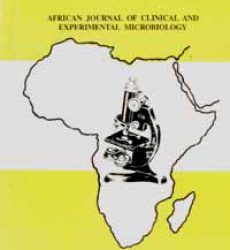Abstract
A total of 125 Neisseria gonorrhoeae strains were isolated from patients attending private clinics in Zaria, Kaduna State, Nigeria. Out of the 125 gonococcal isolates, 90 (72%) were resistant to penicillin G, 85 (68%) to ampicillin, 70 (56%) to tetracycline, 55 (44%) to erythromycin and 26 (22%) isolates were resistant to gentamicin. All the 125 Neisseria gonorrhoeae isolates were susceptible to ceftriaxone, cefuroxime and ofloxacin. Out of the 90 Neisseria gonorrhoeae isolates resistant to penicillin, 65 (72.2%) were positive for β-lactamase production (PPNG). The remaining 25 (27.7%) penicillin resistant strains were β-lactamase negative. The findings of this study have shown high prevalence of multi-drug resistant strains of Neisseria gonorrhoeae amongst attendees of private clinics in Zaria.
African Journal of Clinical Experimental Microbiology Vol. 8 (2) 2007: pp. 101-106
Download full journal in PDF below

